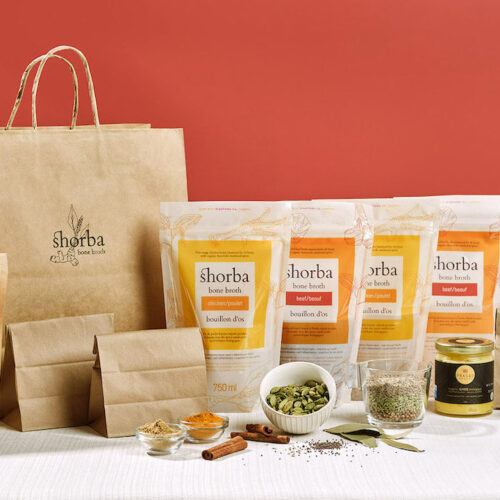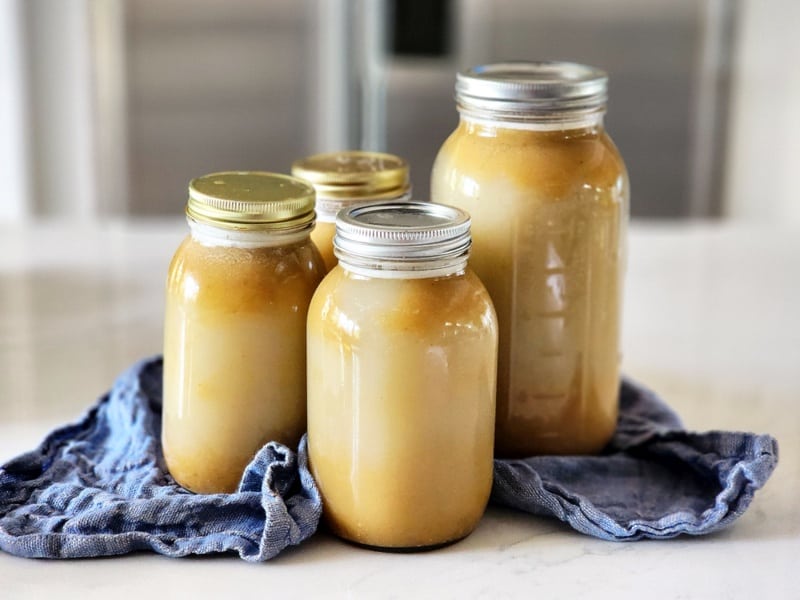How to Make Beef Bone Broth: A Step-by-Step Guide for Delicious Homemade Nutrition
Beef bone broth is a nutritious addition to any type of kitchen area. It uses many wellness advantages and can improve a selection of recipes. The procedure starts with choosing the appropriate bones and ingredients. Recognizing each action is crucial for attaining the very best taste and richness. Nevertheless, numerous home cooks overlook necessary strategies that can raise their broth. What are these techniques, and just how can they change a basic broth into a cooking staple?
Recognizing the Conveniences of Beef Bone Broth
While many individuals appreciate the rich taste of beef bone broth, they might not totally value its numerous wellness benefits. This nourishing potion is known for its high collagen content, which sustains joint health and advertises skin flexibility. The amino acids found in bone brew, such as glycine and proline, play significant roles in muscular tissue repair service and digestive system health and wellness. On top of that, it is rich in minerals like phosphorus, magnesium, and calcium, crucial for preserving solid bones and general health. Bone broth additionally has anti-inflammatory residential or commercial properties, which can relieve symptoms associated with chronic conditions. Eating it might support digestive tract health by enhancing the mucosal lining of the digestion system, promoting far better nutrient absorption. The heat and convenience of a steaming dish of broth can offer a comforting effect, making it a tasty and nourishing option for people seeking both culinary enjoyment and health and wellness advantages. Cooking Picking the Right Bones
The foundation of a savory and nutritious beef bone brew depends on the option of bones. For perfect outcomes, it is vital to pick a variety of bones that provide a rich blend of flavor and nutrients. Marrow bones, which consist of the fatty, gelatinous marrow, are especially valued for their ability to improve the brew's richness. Joint bones, such as oxtails and knuckles, are also useful since they are high in collagen, adding to a silky structure. Furthermore, including some meaningful bones can add depth to the taste profile. Sourcing bones from pasture-raised or grass-fed livestock is a good idea, as these options tend to supply exceptional quality and taste. It is additionally important to identify the bones are complimentary and fresh from any type of off-putting smells. By meticulously selecting the ideal bones, one can lay the foundation for a beneficial and scrumptious beef bone brew.
Necessary Active Ingredients for Flavorful Brew
To develop a tasty beef bone broth, choosing top quality beef bones is crucial as they act as the foundation of the recipe - Beef Bone Broth. Fragrant vegetables and a careful choice of herbs and seasonings further enhance the broth's deepness and complexity. With each other, these necessary ingredients add to a satisfying and rich taste account
High Quality Beef Bones
Quality beef bones act as the structure for a rich and delicious broth. The finest alternatives consist of marrow bones, knuckle bones, and oxtails, each contributing special appearances and tastes. Marrow bones are prized for their gelatin content, which assists develop a smooth mouthfeel. Knuckle bones, rich in collagen, improve the broth's body and nutritional account. Oxtails supply a hearty preference and additional splendor. It is important to source bones from grass-fed or pasture-raised livestock, as this improves the overall high quality and flavor of the broth. Freshness is also essential; bones should be utilized within a couple of days of purchase or frozen for later usage. Picking top quality beef bones ensures a tasty and nourishing end product.
Fragrant Veggies Choice
While picking aromatic veggies, one need to take into consideration the function they play in improving the general flavor account of the beef bone brew. Typical choices consist of onions, carrots, and celery, often referred to as the "mirepoix." Onions add sweetness and depth, while carrots contribute a refined earthiness. Celery gives a renewing clarity that stabilizes the richness of the broth. Garlic, though optional, can present a robust taste, matching the tasty notes of the beef. Leeks and shallots are also excellent enhancements, offering special preference measurements. For a hint of heat and intricacy, some might consist of ginger or fennel. Choosing a mix of these fragrant veggies guarantees a flavorful and versatile brew, establishing the foundation for a beneficial cooking experience.
Flavorful Herbs and Spices
Incorporating flavorful natural herbs and spices is essential for elevating the taste of beef bone broth, as they present aromatic complexity and deepness. Typical choices include bay leaves, which present a refined organic note, and thyme, recognized for its earthy taste. Rosemary, with its pine-like essence, adds a rejuvenating touch, while parsley adds illumination and freshness. For a hint of warmth, black peppercorns and garlic are superb additions, enhancing the brew's general splendor. Additionally, pepper flakes or chili powder can introduce a gentle heat for those who favor a little seasoning. Selecting a balanced combination of these ingredients not just enhances flavor but also instills the brew with beneficial nutrients, making it a beneficial and tasty option for any dish.
Preparing the Bones and Veggies
To produce a savory and rich beef bone broth, the preparation of veggies and bones is essential. Initially, picking premium beef bones, such as marrow, oxtail, or knuckle, is important, as they offer the essential collagen and nutrients. Toasting the bones in the oven enhances their taste, providing the brew a deeper, richer preference. It is a good idea to roast them at 400 ° F for about half an hour, till browned.Next, veggies play a critical role in building flavor. Usual choices consist of onions, carrots, and celery, referred to as the mirepoix base. These should be approximately sliced to take full advantage of flavor removal throughout simmering. Garlic and tomatoes can also be consisted of for added depth.Lastly, washing the veggies and bones under cool water helps eliminate any kind of impurities, making sure a clear brew. Appropriately preparing bones and vegetables sets the foundation for a delicious and beneficial beef bone broth.
Food Preparation Methods: Stovetop vs. Slow Stove
The option between stovetop and sluggish cooker methods presents distinctive advantages when it comes to cooking beef bone broth. Stovetop food preparation enables quicker outcomes and even more control over the simmering procedure, while slow-moving stoves supply convenience and a prolonged infusion of flavors. Each technique has its distinct benefits, dealing with various preferences and timetables.

Stovetop Cooking Benefits
While both stovetop and slow cooker approaches have their advantages, stovetop cooking supplies distinct advantages that can boost the procedure of making beef bone brew. One considerable advantage is the capability to control the temperature and simmering time much more specifically, which can result in optimal removal of nutrients and flavors from the bones. In addition, stovetop cooking permits real-time adjustments, allowing the cook to monitor the broth's consistency and preference throughout the process. The quicker food preparation time compared to slow down stoves can likewise be beneficial for those requiring broth in a shorter timeframe. The stovetop method urges a hands-on strategy, cultivating a much deeper connection to the cooking process and possibly resulting in a more delicious end item.
Slow Cooker Advantages
Making use of a slow-moving stove for making beef bone broth supplies numerous distinctive benefits that appeal to several home cooks. One primary advantage is the benefit of set-it-and-forget-it food preparation. When the active ingredients are incorporated, the sluggish cooker can operate ignored for hours, enabling an active timetable without consistent tracking. Furthermore, slow-moving cookers preserve a constant reduced temperature, which extracts nutrients and tastes efficiently in time without the risk of boiling, leading to a richer broth. The power efficiency of sluggish cookers likewise sticks out, as they make use of less electrical energy contrasted to stovetops (Where To Buy Bone Broth Near Me). In addition, sluggish cookers frequently have programmable setups, making it possible for exact control over cooking times, which boosts the total convenience of broth prep work
Straining and Keeping Your Brew
Straining and saving beef bone brew is a vital action that ensures a clear, delicious last product. As soon as the brew has simmered for the recommended time, it ought to be very carefully poured through a great mesh strainer or cheesecloth into a large bowl or pot. This process eliminates any solids, such as meat, vegetables, and bones, assuring a smooth consistency. To record all taste, pushing the solids carefully with a spoon can be beneficial.After straining, the brew must cool to space temperature level prior to being stored. It is best to make use of impermeable containers, such as glass containers or freezer-safe bags, to avoid freezer melt and keep freshness. Classifying the containers with the date is additionally suggested. you can try here The brew can be Our site refrigerated for as much as a week or frozen for a number of months, making it a practical enhancement to future dishes. Proper storage guarantees that the dietary benefits and flavors continue to be intact.
Imaginative Ways to Use Beef Bone Brew
Beef bone broth supplies a versatile structure for a selection of recipes, improving both flavor and nourishment. Home chefs can include it right into stews and soups, giving a rich base that deepens the total preference. It can also be used as a cooking fluid for grains, such as rice or quinoa, infusing them with added nutrients and flavor.Additionally, beef bone brew offers as an outstanding structure for gravies and sauces, offering intricacy and richness to dishes. For those looking for a healthy and balanced drink, sipping warm brew can be beneficial and relaxing. It can also be made use of in shakes for a protein increase, though this might require some imaginative flavor balancing.Ultimately, beef bone broth not only boosts day-to-day recipes yet additionally adds to a wholesome diet, making it a staple ingredient for culinary fanatics and health-conscious individuals alike.
Often Asked Inquiries
How Lengthy Can I Shop Beef Bone Brew in the Refrigerator?
The concern of storage space duration for beef bone broth in the refrigerator is essential. Usually, it can be securely saved for regarding 3 to five days, guaranteeing quality and quality prior to intake or cold for longer preservation.
Can I Freeze Beef Bone Broth, and for How much time?
Beef bone brew can be frozen properly, permitting prolonged storage. When properly sealed in airtight containers, it can last as much as six months in the fridge freezer, protecting its flavor and nutritional benefits for later usage.
Is It Safe to Use Bones From a Supermarket?
The safety and security of making use of supermarket bones depends upon their source and handling. If properly sourced and kept, these bones can be safe for usage, offering crucial nutrients when ready properly for brew.
Can I Make Beef Bone Brew in an Immediate Pot?
The Immediate Pot is undoubtedly ideal for making beef bone brew - Beef Bone Broth. Its pressure cooking attribute substantially decreases cooking time while still extracting rich flavors and nutrients, making it a practical alternative for active home cooks

What Nutritional Distinctions Exist Between Beef and Chicken Bone Broth?
The dietary index differences in between beef and hen bone brew mainly lie in their collagen web content, amino acids, and mineral profiles. Beef brew typically has even more collagen and minerals, while chicken broth is typically lighter and easier to digest. The structure of a tasty and healthy beef bone broth lies in the choice of bones. To develop a flavorful beef bone broth, choosing top quality beef bones is crucial as they serve as the foundation of the meal. The ideal options consist of marrow bones, knuckle bones, and oxtails, each adding distinct structures and flavors. While picking aromatic veggies, one need to think about the role they play in enhancing the overall flavor profile of the beef bone broth. To create a savory and abundant beef bone broth, the prep work of vegetables and bones is important.